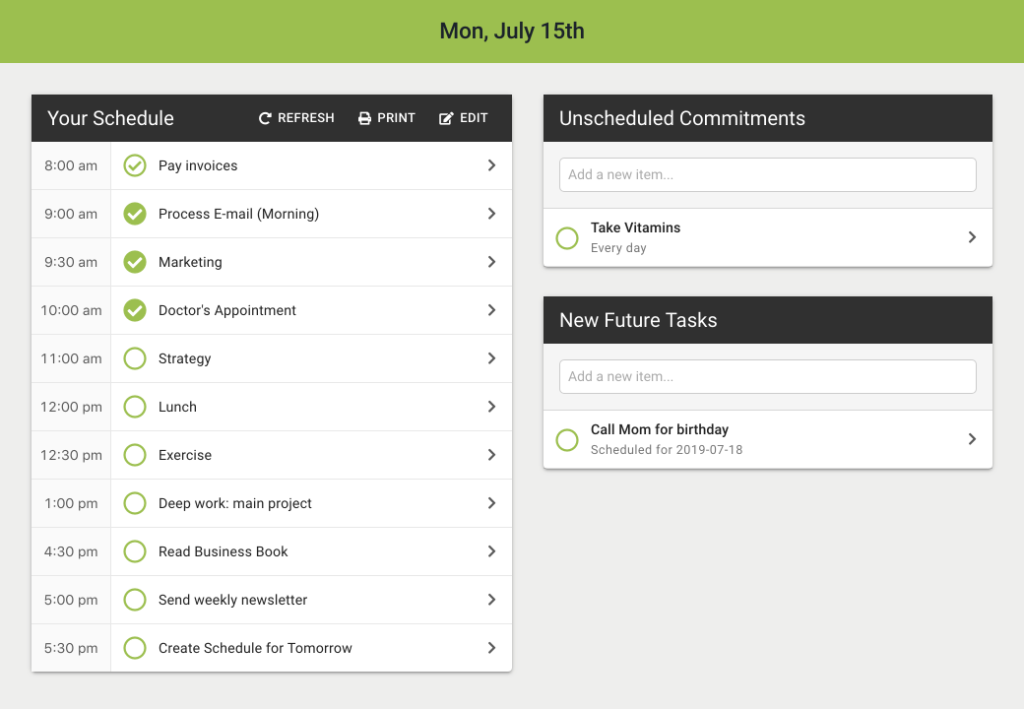In the fast-paced world of work, it’s easy to get lost in the never-ending to-do lists and deadlines, often forgetting to take a moment to pause and reflect.
Enter checkpoints—a way of bringing mindfulness back into your work.
Checkpoints are like little beacons of awareness, guiding you to make intentional decisions and stay on track with your priorities. Let’s explore how you can harness the power of checkpoints to bring mindfulness into your daily work routine.
What is a Checkpoint?
Checkpoints are pre-defined moments of mindfulness. A decision you make before you start work to stop at specific points to evaluate your progress and decide on the best path forward.
Checkpoints act as gentle reminders to pop your head up from the trenches of work and check in on the progress you’ve made against your plan. They consist of a trigger to stop, a question to ask and a default path to take assuming your question brings no new insights.
At a checkpoint, you get to decide whether to continue along your current path or pivot to a new one. These moments of reflection can prevent you from mindlessly plowing through tasks and allow you to re-evaluate your approach to your task—or even whether you should be doing the task at all.
Identifying Effective Trigger Conditions
To create effective checkpoints, you need trigger conditions that are objective and easily recognizable. Consider the following common trigger conditions:
- Time
Set a checkpoint for a specific time or after a predetermined duration. This could be the end of a work session or a time block dedicated to a particular task. You can even set multiple checkpoints during a time block, such as those created implicitly when using pacers. - Progress
Base your checkpoint on measurable progress. It could be word count if you’re writing, distance if you’re running, or revenue earned if you’re involved in sales. - Events
Use events as triggers for checkpoints. These events could mark the start or end of a specific phase or project. - People
Consider incorporating interactions with others into your checkpoints. A checkpoint could be triggered when someone important arrives, leaves, or contacts you. - Resources
Running low on essential resources? Make that a trigger for a checkpoint. For example, when your laptop’s battery power is about to die, it’s time to assess your progress.
Remember, the key is to have triggers that are easy to measure and recognize quickly. Avoid subjective measures or resources that require substantial effort to calculate, as they can lead to confusion and hinder the effectiveness of your checkpoints.
Crafting Effective Checkpoints
An effective checkpoint should have a default path. These aren’t times to re-evaluate your entire strategy—unless you come to some dramatic new insight that indicates you should—but rather gentle points to check in with yourself.
Most of the time your checkpoints should be brief relative to your total plan. Checkpoints for time blocks might only be a minute or two, while checkpoints on monthly or yearly plans might be up to an hour or more.
Here’s a simple framework to create impactful checkpoints:
- Choose a Default Path
Decide on a default path for your checkpoint. This means knowing what your next step will be if you don’t encounter any compelling reasons to deviate. Normally this will be to just continue working, but it could also be to take a break, send a progress report or something else entirely. - Pose a Question
Accompany your checkpoint with a question to ask yourself. This question should help you decide whether to continue on your default path or explore an alternative route. Common questions include “Is this the best use of my time?”, “How can I complete this task more effectively?” or “What compromises do I need to make to finish on time?”
For instance, let’s say you set a checkpoint at the end of a time block for a particular task. The default path could be to move on to the next task. The question to ask yourself is, “Is the task I am currently working on more important than my next task?” If it is, then feel free to deviate from the default path and continue with the current task. If not, follow the default path and switch to the next task.
The Power of Adaptability: Forging a New Path
An essential aspect of checkpoints is that they allow for adaptability. You don’t need to decide on an alternate path upfront—just focus on your default path. Use checkpoints as opportunities to reevaluate your execution plan and ensure it still aligns with your goals.
For example, if you’re in the process of writing the first draft of a book, create a checkpoint at the end of each chapter. At this point, ask yourself, “Does the outline still make sense?” If it does, continue writing the next chapter. If not, take a step back, return to the outline, and figure out how to make the necessary changes.
Checkpoints come in especially handy when you tend to fall down rabbit holes, easily lose track of time, or find yourself reaching the point of diminishing returns. They offer enough awareness to stop yourself before going too far astray.
Benefits of Checkpoints
As you have likely surmised, checkpoints bring several benefits into your work:
- Mindful Reflection
Checkpoints introduce mindfulness into your work routine. By pausing to evaluate your progress and choices, you cultivate self-awareness and a deeper understanding of your actions. - Intentional Decision-Making
Embracing checkpoints empowers you to make deliberate decisions. Rather than operating on autopilot, you consciously assess the value and direction of your work. - Course Correction
Through checkpoints, you can course correct before straying too far off track. This adaptability ensures that you remain aligned with your goals and priorities. - Efficiency and Focus
Regularly implementing checkpoints helps you stay focused on the most important tasks and avoid wasting time on unproductive pursuits. - Preventing Burnout
By incorporating moments of reflection, you reduce the risk of burnout by recognizing when to pause, recharge, and regain clarity. - Boosting Productivity
With a clear understanding of your progress, you can optimize your efforts and make the most of your valuable time and energy.
You may find other benefits as well. Those who like structure can find checkpoints bring a sense of calm into their work, while those who tend to get lost in their work find it helps remind them of the need for work-life balance.
Embrace Mindful Productivity with Checkpoints
By incorporating checkpoints into your work, you can infuse mindfulness into your individual tasks and the execution of your overall strategy. These moments of awareness help you take a step back and ensure you are working on the right stuff in the right way.
Remember, the beauty of checkpoints lies in their simplicity: set clear trigger conditions, establish default paths, and ask yourself meaningful questions. Embrace the power of checkpoints, and you’ll find yourself navigating the waters of work with greater intention and focus.
What checkpoints will you set today?








